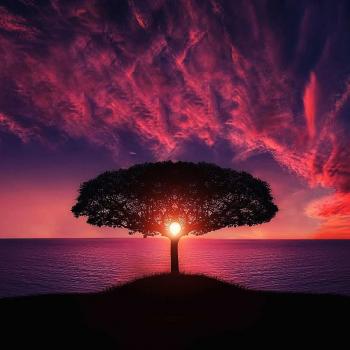 As we look for meaning in our lives, each passing year gives us more opportunity to understand the clues from the past. From the broader perspective of age, we gain the advantage of reminiscence over the many events, dreams, and stories that have decorated our journey. Kierkegaard’s famous saying that life can only be lived forward, but it must be understood looking backward––and Socrates’ admonition that “The unexamined life is not worth living”–– inspired me to examine my past from the perspective of my present age. The synchronicities and patterns I discovered led me to research karma. . .and I found something completely different from what I expected!
As we look for meaning in our lives, each passing year gives us more opportunity to understand the clues from the past. From the broader perspective of age, we gain the advantage of reminiscence over the many events, dreams, and stories that have decorated our journey. Kierkegaard’s famous saying that life can only be lived forward, but it must be understood looking backward––and Socrates’ admonition that “The unexamined life is not worth living”–– inspired me to examine my past from the perspective of my present age. The synchronicities and patterns I discovered led me to research karma. . .and I found something completely different from what I expected!
In Part One, I will discuss what karma means, what it does, and how the energy of thought patterns is believed to influence events in the outer world.
In Part Two, I will list the types and the 12 laws of karma, and then summarize the key lessons of karma.
Part One: What is karma?
Perhaps your understanding of karma is similar to what mine had been: I thought that karma was a religious term implying a fixed destiny, meaning that all actions in a past life, whether good or bad, were rewarded or punished during our reincarnation in this life. I was wrong on all counts.
Karma is not a religious term. Not a judgment from a past life. And unlike so many religions wherein God rewards or punishes all human actions after death, karma is independent of any deity or process of divine judgment. Even the idea of rebirth over successive lifetimes is not essential to karma. Why? because change is always possible in the present time. I repeat: karma is not a static telling of fortune, fate, or destiny.
Historically, Karma, which is a Sanskrit word dating back to the Rig Veda about 1500 BCE, meant ‘ritual action’ Over time its definition was extended in the Upanishads (800-300 BCE) to include both moral and ethical dimensions.
Morally speaking, karma is not in itself a reward or punishment, but rather it’s the law that produces consequences in life. These consequences may be material, moral, or emotional and may not appear immediately. But sooner or later, they will appear.
In ethical terms, karma links not only one’s actions to a future result, but also one’s intentions and thoughts. As Gandhi, explained, “A man is but the product of his thoughts. What he thinks, he becomes.” Karma then is a product of one’s ongoing thoughts and actions, and personal karma depends on what you create and express. It is similar to Galatians 6:7, “whatsoever one sows, that will he also reap” This law of cause and effect has been called the “Great Law,” and it is the very first of the 12 laws of karma.
Now, it’s easy to understand that actions usually bring results, but thought patterns are also energy. And since energy is neither created nor destroyed, past and present are inextricably linked. Einstein called this sense of connectedness “the cosmic religious feeling.” Certainly, we trust our prayers to be thoughts that God will answer.
But how does an intention or a thought within us create an effect in the outer physical world?
Let me ask you, have you ever received a phone call from a person just as you were thinking about calling her or him? We call such events ‘coincidences,’ and it’s entirely likely that they occur much more often than we happen to notice them. Einstein also said, “Coincidence is God’s way of remaining anonymous.”
The psychologist Carl Jung used the term ‘synchronicity’ to explain two events that come together when no clear cause and effect can be shown––something like those almost overlapping phone calls. Jung’s idea of synchronicity comes very close to describing karma as well. In Jung’s terms, thoughts and events are essentially interconnected and meaningful; they are the twin aspects of a unified reality that connects everything and everyone. Today’s quantum physicists and neuroscientists would agree; they have discovered events such as “action at a distance,” or entanglement, when what happens to one object affects another previously related object even without any physical contact, no matter how great the distance between them. Now scientists are connecting consciousness to the universe itself. Basically, they suggest that all matter has some form of consciousness, and everything leads back to the conscious observer. As we seek to understand ourselves, one continuum to follow might be from brain to consciousness to mind to the interconnectedness of all life and then to spirituality.
Like thought patterns, then, karma by its very nature as energy can neither be created nor destroyed. But karma can be transformed, modified, changed, or suspended. Albert Schweitzer, among others, noted “the greatest discovery of any generation is that human beings can alter their lives by altering their attitudes of mind.” In this sense, karma gives each of us an ongoing opportunity to create our life and to shape who and what we are. No one is a passive victim of fate or circumstance or a past life. What good are lessons if we can’t change the past? But each one of us can choose the future. Karma is a blueprint for education and learning, a map pointing the way to new choices. It definitely is not a passive state. It is a challenge to change.
I realized that in order to create the changes we desire, three important steps were necessary. First, it is critical to set a clear intention, a definite purpose of what one wants to happen. Second, one must use the power of a strong will to make it real. And finally, one has to take the necessary actions. The results can be, and often are, amazing. As Goethe wrote,
That moment one definitely commits oneself, then providence moves, too. All sorts of things occur to help one that would never otherwise have occurred. A whole stream of events issues from the decision, raising in one’s favor all manner of unforeseen incidents and meetings and material assistance, which no man could have dreamed would have come his way.












